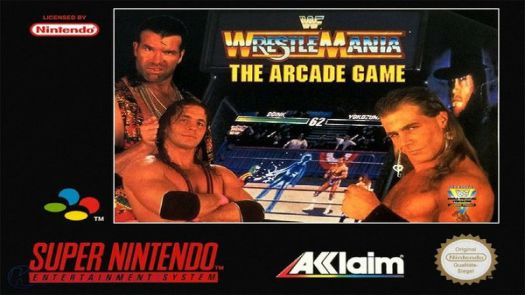
The Sega Saturn and Playstation versions featured even more of this than the 16-bit releases did. Sound bytes of then-WWF announcers Jerry “The King” Lawler and Vince McMahon were well done. The BGM left a little much to be desired, especially on the SNES version of the game.


Each wrestler’s music was well-represented on all platforms as well. The ring was attractive and well scaled to the wrestlers, and the crowd, a longtime issue in not only wrestling games, but sports games as a whole, were up to par with other games of its time period. The animations were very well done, which led to a smooth pace and fluid movement of players in each match. The graphics were a step above the previous WWF entries as well, featuring digitized images of each wrestler, all of which were painstakingly recreated via motion capture. The action was more fast-paced than its predecessors, as well. The Undertaker would ‘bleed’ bones and skulls, Bret Hart would ‘bleed’ hearts, etc. For example, each wrestler had projectile attacks, uppercuts that would knock the opponent sky high, and the combatants ‘bled’ objects that pertained to their character. The combat style also was modeled after popular fighting games.

Instead of a traditional wrestling match, each bout is comprised of a best 2 out of 3 round type match, just like in Street Fighter or Mortal Kombat. It was a bold move, for sure, and led to what could have been a very interesting concept, had it been marketed properly. This may have left many people disappointed when they played it for the first time, as the game was a radical departure from what gamers had come to expect from wrestling games. Like I mentioned above, WWF The Arcade Game is much more of a fighting game than it is a wrestling game. What follows is the product of that weird time period between the Hogan Era and the Attitude Era, combined with arcade trends of the day. The WWF took a cue from these red-hot arcade properties and partnered up with Midway to release this quasi-hybrid wrestling and fighting game. Released at a time when the WWF was reeling from the departure of many of it’s 80’s stars like Hulk Hogan, it was also a time when games like NBA Jam and Mortal Kombat ruled the arcades.

These games were great, but after awhile they became stale and predictable. The more prominent releases that we saw in the post-NES era were those of the “Super Wrestlemania” series, which spawned a couple of sequels. Back when the WWE went by the name WWF, we were treated to many memorable games on our various home consoles.


 0 kommentar(er)
0 kommentar(er)
